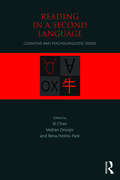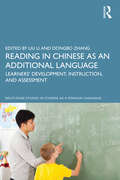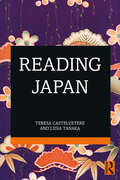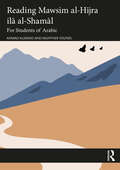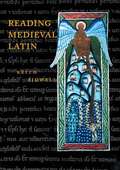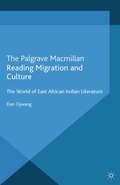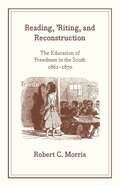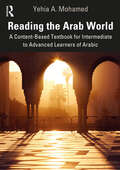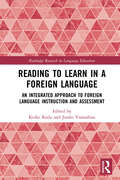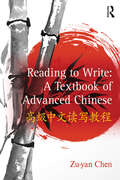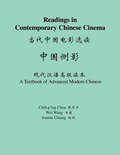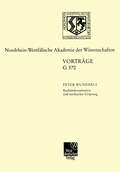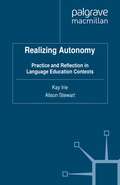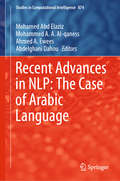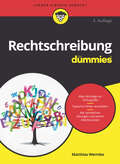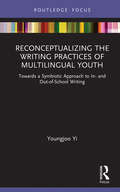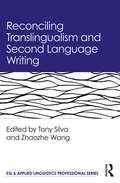- Table View
- List View
Reading in a Second Language: Cognitive and Psycholinguistic Issues
by Xi Chen Rena Helms-Park Vedran DronjicReading in a Second Language offers a comprehensive survey of the phenomenon and process of reading in a second language, with graduate and upper-level undergraduate students in second language acquisition, psycholinguistics, and applied psychology as its primary audience. The book explores reading processes from a number of complementary standpoints, integrating perspectives from fields such as first and second language reading, second language acquisition, linguistics, psycholinguistics, and cognitive neuroscience. The first half examines major factors in second language reading: types of scripts, the cognitive and neural substrates of reading; metalinguistic awareness, word recognition, language transfer, and lexical knowledge. The second part of the book discusses the social and educational contexts in which reading development occurs, including issues related to pedagogy, the use of technology in the classroom, reading disorders, and policy making. Reading in a Second Language provides students with a full, logically organized overview of the primary factors that shape reading development and processes in a second language.
Reading in Chinese as an Additional Language: Learners’ Development, Instruction, and Assessment (Routledge Studies in Chinese as a Foreign Language)
by Liu Li Dongbo ZhangReading in Chinese as an Additional Language focuses on Chinese literacy acquisition, which has been considered most difficult by both learners and teachers of Chinese as an additional language (CAL). Three major areas are covered: (1) acquisition of Chinese characters; (2) reading comprehension subskills and reader’s identity; (3) reading instruction and assessment. The first part delves into the foundation of Chinese literacy development—how to learn and teach Chinese characters. The second part examines various learners’ reading comprehension subskills, as well as the evolution of learners’ literacy identity. The third part explores effective instructional methods and assessment practices for CAL reading development. Theoretically, this book provides frameworks and evidence from both cognitive and sociocultural perspectives on the nature of CAL reading development. Pedagogically, the book showcases how to teach and assess CAL reading skills. Methodologically, this book includes empirical studies using both qualitative and quantitative methods. In terms of scope, the book covers a much broader spectrum of issues about CAL reading research and classroom teaching than has previously been available. Writing is also discussed in several chapters. In terms of technology, the book includes discussion on how the use of computers, the Internet, and social media impacts students’ Chinese literacy acquisition. This book will help CAL researchers and educators better understand the nature of CAL reading development and become well informed about CAL classroom teaching and assessment, including the application of interactive approaches to teaching and assessing diverse reading skills.
Reading in Chinese as an Additional Language: Learners’ Development, Instruction, and Assessment (Routledge Studies in Chinese as a Foreign Language)
by Liu Li Dongbo ZhangReading in Chinese as an Additional Language focuses on Chinese literacy acquisition, which has been considered most difficult by both learners and teachers of Chinese as an additional language (CAL). Three major areas are covered: (1) acquisition of Chinese characters; (2) reading comprehension subskills and reader’s identity; (3) reading instruction and assessment. The first part delves into the foundation of Chinese literacy development—how to learn and teach Chinese characters. The second part examines various learners’ reading comprehension subskills, as well as the evolution of learners’ literacy identity. The third part explores effective instructional methods and assessment practices for CAL reading development. Theoretically, this book provides frameworks and evidence from both cognitive and sociocultural perspectives on the nature of CAL reading development. Pedagogically, the book showcases how to teach and assess CAL reading skills. Methodologically, this book includes empirical studies using both qualitative and quantitative methods. In terms of scope, the book covers a much broader spectrum of issues about CAL reading research and classroom teaching than has previously been available. Writing is also discussed in several chapters. In terms of technology, the book includes discussion on how the use of computers, the Internet, and social media impacts students’ Chinese literacy acquisition. This book will help CAL researchers and educators better understand the nature of CAL reading development and become well informed about CAL classroom teaching and assessment, including the application of interactive approaches to teaching and assessing diverse reading skills.
Reading Japan
by Teresa Castelvetere Lidia TanakaReading Japan offers the student readings on geopolitics, education, language, Japanese-ness and ethnicity, gender and history, with the dual aims of broadening students’ understanding of Japan and of providing opportunities to read authentic Japanese texts. Each chapter contains an essay in English, a selection of readings in Japanese, comprehensive vocabulary lists, discussion questions and a list of sources and additional readings. Pitched at Intermediate to Advanced and B1-C1 level, this reader is not simply a language textbook; it offers students a chance to learn and think in depth about Japan as they build confidence in reading real-world Japanese texts.
Reading Mawsim al-Hijra ilā al-Shamāl: For Students of Arabic
by Ahmad Alswaid Munther YounesReading Mawsim al-Hijra ilā al-Shamāl: For Students of Arabic is intended for advanced students of Arabic who have studied the language for at least two years at college level or the equivalent. The book is based on Tayeb Salih’s novel Mawsim al-Hijra ilā al-Shamāl, a masterpiece in modern Arabic literature. This book is designed to accompany the novel, which the authors divided into 60 parts, each of which consists of 400–500 words of the original text. A lesson is built on each part and starts with a reference to the first and last sentences in it. This is followed by a list of new vocabulary and a variety of activities and exercises, some oral and some written, whose goal is to develop students’ listening, speaking, reading, and writing skills and knowledge of Arabic language, culture, and literature. The book ends with a glossary of literary terms. The book’s e-resources include a comprehensive glossary of words arranged by root, a glossary of expressions, and other resources. The book can be used as a main or a supplementary text in an Arabic language course or for independent study.
Reading Mawsim al-Hijra ilā al-Shamāl: For Students of Arabic
by Ahmad Alswaid Munther YounesReading Mawsim al-Hijra ilā al-Shamāl: For Students of Arabic is intended for advanced students of Arabic who have studied the language for at least two years at college level or the equivalent. The book is based on Tayeb Salih’s novel Mawsim al-Hijra ilā al-Shamāl, a masterpiece in modern Arabic literature. This book is designed to accompany the novel, which the authors divided into 60 parts, each of which consists of 400–500 words of the original text. A lesson is built on each part and starts with a reference to the first and last sentences in it. This is followed by a list of new vocabulary and a variety of activities and exercises, some oral and some written, whose goal is to develop students’ listening, speaking, reading, and writing skills and knowledge of Arabic language, culture, and literature. The book ends with a glossary of literary terms. The book’s e-resources include a comprehensive glossary of words arranged by root, a glossary of expressions, and other resources. The book can be used as a main or a supplementary text in an Arabic language course or for independent study.
Reading Medieval Latin
by Keith C. SidwellReading Medieval Latin is an anthology of Medieval Latin texts, arranged chronologically and thematically with introductions, commentaries and a vocabulary of nonclassical words and meanings. It is a language textbook, designed to introduce students with one year or more of Latin to the Latin writing and culture of the period A. D. 550-1200. It is the only systematic introduction for students to all types of Medieval Latin writing.
Reading Migration and Culture: The World of East African Indian Literature
by Dan OjwangThis book uses the uniquely positioned culture of East African Asians to reflect upon the most vexing issues in postcolonial literary studies today. By examining the local histories and discourses that underpin East African Asian literature, it opens up and reflects upon issues of alienation, modernity, migration, diaspora, memory and nationalism.
Reading Petronius
by Niall W. Slater[Amazon] Review "Slater has written a highly readable book about Petronius' tantalizing work, using modern critical methods ably to inform his presentation... This book offers much for students of Petronius and of skillfully applied criticism." -- Classical World
Reading, 'Riting, and Reconstruction: The Education of Freedmen in the South, 1861-1870
by Robert C. MorrisThis study of education for freedmen following Emancipation is the definitive treatment of the subject. Employing a wide range of sources, Robert C. Morris examines the organizations that staffed and managed black schools in the South, with particular attention paid to the activities of the Freedman’s Bureau. He looks as well at those who came to teach, a diverse group—white, black, Northern, Southern—and at the curricula and textbooks they used. While giving special emphasis to the Freedmen’s Bureau school program, Morris places the freedmen’s educational movement fully in its nineteenth-century context, relating it both to the antislavery crusade that preceded it and to the conservative era of race relations that followed.
Reading the Arab World: A Content-Based Textbook for Intermediate to Advanced Learners of Arabic
by Yehia A. MohamedReading the Arab World is a content-based textbook for intermediate to advanced students of Arabic, designed to enhance language skills through exposure to authentic texts. Students will develop their reading, writing, speaking, and critical thinking skills as they learn about the most contemporary issues shaping the Arab world through a range of authentic texts. The choice of texts and authors is diverse and includes texts from various sources and geographical regions in the Arab world, as well as authors of different genders, ages, generations, and schools of thought, thus ensuring a compelling range of viewpoints and angles. Each text is supported by relevant tasks such as vocabulary exercises, comprehension activities, and discussion questions. This is an ideal resource for students of Arabic as a second or heritage language, working at or above the Intermediate-High level on the ACTFL proficiency scale.
Reading the Arab World: A Content-Based Textbook for Intermediate to Advanced Learners of Arabic
by Yehia A. MohamedReading the Arab World is a content-based textbook for intermediate to advanced students of Arabic, designed to enhance language skills through exposure to authentic texts. Students will develop their reading, writing, speaking, and critical thinking skills as they learn about the most contemporary issues shaping the Arab world through a range of authentic texts. The choice of texts and authors is diverse and includes texts from various sources and geographical regions in the Arab world, as well as authors of different genders, ages, generations, and schools of thought, thus ensuring a compelling range of viewpoints and angles. Each text is supported by relevant tasks such as vocabulary exercises, comprehension activities, and discussion questions. This is an ideal resource for students of Arabic as a second or heritage language, working at or above the Intermediate-High level on the ACTFL proficiency scale.
Reading to Learn in a Foreign Language: An Integrated Approach to Foreign Language Instruction and Assessment (Routledge Research in Language Education)
by Keiko Koda Junko YamashitaThis book describes a theory-guided approach to Foreign Language (FL) course development, implementation, instruction and assessment. It documents the development and implementation of a theory-guided approach designed to exploit cross-linguistically sharable competencies as resources for promoting FL learning. The volume delineates the processes of (a) identifying cross-linguistically sharable competencies, (b) exploring ways of exploiting sharable competencies as resources in promoting language skills through their purposeful use for content learning, (c) implementing the instructional approach in multiple EFL classrooms, and (d) evaluating the approach by comparing learning outcomes across classrooms. It presents a solid conceptual framework that integrates theories in multiple research domains, including second language acquisition, knowledge acquisition, and language assessment. It also provides detailed descriptions of framework construction and classroom implementation – the two processes that are integral to course design and development.
Reading to Learn in a Foreign Language: An Integrated Approach to Foreign Language Instruction and Assessment (Routledge Research in Language Education)
by Keiko Koda Junko YamashitaThis book describes a theory-guided approach to Foreign Language (FL) course development, implementation, instruction and assessment. It documents the development and implementation of a theory-guided approach designed to exploit cross-linguistically sharable competencies as resources for promoting FL learning. The volume delineates the processes of (a) identifying cross-linguistically sharable competencies, (b) exploring ways of exploiting sharable competencies as resources in promoting language skills through their purposeful use for content learning, (c) implementing the instructional approach in multiple EFL classrooms, and (d) evaluating the approach by comparing learning outcomes across classrooms. It presents a solid conceptual framework that integrates theories in multiple research domains, including second language acquisition, knowledge acquisition, and language assessment. It also provides detailed descriptions of framework construction and classroom implementation – the two processes that are integral to course design and development.
Reading to Write: A Textbook of Advanced Chinese
by Zu-Yan ChenTraditionally, reading and writing are believed to be separate but related language processes and teachers follow the conventional wisdom of teaching in-depth reading, with writing as a tag-on issue. Therefore, there exists an increasingly urgent call for a well-rounded reading-writing curriculum and a theoretically-informed, empirically-based, student-centered advanced textbook that aims to develop the synergy between reading and writing. Reading to Write: A Textbook of Advanced Chinese is intended to fill this significant gap. It treats reading and writing as integrative parts and interactive skills in Chinese language teaching, putting them hand-in-hand, supplementing each other.
Reading to Write: A Textbook Of Advanced Chinese
by Zu-yan ChenTraditionally, reading and writing are believed to be separate but related language processes and teachers follow the conventional wisdom of teaching in-depth reading, with writing as a tag-on issue. Therefore, there exists an increasingly urgent call for a well-rounded reading-writing curriculum and a theoretically-informed, empirically-based, student-centered advanced textbook that aims to develop the synergy between reading and writing. Reading to Write: A Textbook of Advanced Chinese is intended to fill this significant gap. It treats reading and writing as integrative parts and interactive skills in Chinese language teaching, putting them hand-in-hand, supplementing each other.
Readings in Contemporary Chinese Cinema: A Textbook of Advanced Modern Chinese
by Chih-P'Ing Chou Joanne ChiangMost Chinese-language textbooks today cater to beginners and intermediate-level students, but virtually none address the unique needs of advanced students seeking to expand or reinforce their language skills in one semester. Readings in Contemporary Chinese Cinema fills this gap through the use of critically acclaimed Chinese films to teach students Chinese while also broadening their knowledge about China. The authors have carefully chosen ten movies produced in recent decades by filmmakers from mainland China, Taiwan, and Hong Kong. Set broadly within the twentieth century, these classic films are representative of both urban and rural life, and vividly depict the diversity of perspectives that comprise contemporary Chinese society. The authors provide an informative synopsis and critique of each movie, and include selections of movie dialogue that allow students to practice and build proficiency. The comprehensive lessons are supplemented with exercises, sentence-pattern examples, English-language glossaries, and extensive vocabulary lists. There are also discussion questions that can be used in conjunction with screenings of the films. Readings in Contemporary Chinese Cinema is designed for students with three or more years of college-level instruction in modern Chinese, and can be used alone or as a sequel to Anything Goes: An Advanced Reader of Modern Chinese. It has been proven effective at Princeton University and in the Princeton in Beijing program, and is ideal for those returning from study abroad in China.
Realitätskonstitution und mythischer Ursprung: Zur Entwicklung der italienischen Schriftsprache von Dante bis Salviati (Forschungsberichte des Landes Nordrhein-Westfalen #370)
by Peter WunderliRealizing Autonomy: Practice and Reflection in Language Education Contexts
by Kay Irie Alison StewartRealizing Autonomy: Practice and Reflection in Language Education Contexts presents critical practitioner research into innovative approaches to language learner autonomy. Writing about experiences in a range of widely differing contexts, the authors offer fresh insights and perspectives on the challenges and contradictions of learner autonomy.
Recent Advances in NLP: The Case of Arabic Language (Studies in Computational Intelligence #874)
by Mohamed Abd Elaziz Mohammed A. A. Al-qaness Ahmed A. Ewees Abdelghani DahouIn light of the rapid rise of new trends and applications in various natural language processing tasks, this book presents high-quality research in the field. Each chapter addresses a common challenge in a theoretical or applied aspect of intelligent natural language processing related to Arabic language. Many challenges encountered during the development of the solutions can be resolved by incorporating language technology and artificial intelligence.The topics covered include machine translation; speech recognition; morphological, syntactic, and semantic processing; information retrieval; text classification; text summarization; sentiment analysis; ontology construction; Arabizi translation; Arabic dialects; Arabic lemmatization; and building and evaluating linguistic resources.This book is a valuable reference for scientists, researchers, and students from academia and industry interested in computational linguistics and artificial intelligence, especially for Arabic linguistics and related areas.
Rechtschreibung für Dummies (Für Dummies)
by Matthias WermkeBeim Thema Rechtschreibung zucken viele zusammen. Schon in der Schule waren den meisten Diktate ein Graus. Groß- oder kleinschreiben, auseinander oder zusammen, und wo überhaupt muss ein Komma stehen oder ein Bindestrich? Peinlich, wenn dann später das Bewerbungsschreiben vor Fehlern nur so strotzt, die Examensarbeit inhaltlich zwar top, in Sachen Orthografie aber ein Flop ist oder in der Geschäftskorrespondenz mit wichtigen Kunden unzählige Kommafehler stecken. Ebenfalls unschön, wenn Newsletter und Flyer mehr durch ihre mangelhafte Rechtschreibung als durch ihren Inhalt auffallen. Hinzu kommt die Gewissheit, dass auf das Korrekturprogramm des PC auch kein Verlass ist. Und obendrein noch das Hin und Her um die Rechtschreibung in den letzten Jahren. Wer weiß da überhaupt noch, was Sache ist? Bald Sie, wenn Sie sich mit diesem Buch schlau machen!
Reconceptualizing the Writing Practices of Multilingual Youth: Towards a Symbiotic Approach to In- and Out-of-School Writing (Routledge Research in Literacy Education)
by Youngjoo YiFocusing on adolescent multilingual writing, this text problematizes the traditional boundaries between academic writing in school contexts and self-initiated writing outside of the formal learning environment. By reconceptualizing the nature of adolescent multilingual writing, the author establishes it as an interdisciplinary genre and a key area of inquiry for research and pedagogy. Organized into six chapters, Reconceptualizing the Writing Practices of Multilingual Youth provides an in-depth examination of the writing practices of multilingual youth from sociocultural and social practice perspectives. Drawing on first-hand research conducted with young people, the text questions the traditional dichotomy between academic writing and non-formal equivalents and proposes a symbiotic approach to exploring and cultivating the connections between in- and out-of-school literate lives. By highlighting a bidirectional relationship between formal and informal writing, the text advocates for writing instruction that helps adolescents use writing for entertainment, identity construction, creative expression, personal well-being, and civic engagement, as well as helps them learn to navigate future literacies that we cannot imagine or predict now. This much-needed text will provide researchers and graduate students with a principled overview and synthesis of adolescent multilingual writing research that is significant yet underexplored in applied linguistics, TESOL, and literacy studies.
Reconceptualizing the Writing Practices of Multilingual Youth: Towards a Symbiotic Approach to In- and Out-of-School Writing (Routledge Research in Literacy Education)
by Youngjoo YiFocusing on adolescent multilingual writing, this text problematizes the traditional boundaries between academic writing in school contexts and self-initiated writing outside of the formal learning environment. By reconceptualizing the nature of adolescent multilingual writing, the author establishes it as an interdisciplinary genre and a key area of inquiry for research and pedagogy. Organized into six chapters, Reconceptualizing the Writing Practices of Multilingual Youth provides an in-depth examination of the writing practices of multilingual youth from sociocultural and social practice perspectives. Drawing on first-hand research conducted with young people, the text questions the traditional dichotomy between academic writing and non-formal equivalents and proposes a symbiotic approach to exploring and cultivating the connections between in- and out-of-school literate lives. By highlighting a bidirectional relationship between formal and informal writing, the text advocates for writing instruction that helps adolescents use writing for entertainment, identity construction, creative expression, personal well-being, and civic engagement, as well as helps them learn to navigate future literacies that we cannot imagine or predict now. This much-needed text will provide researchers and graduate students with a principled overview and synthesis of adolescent multilingual writing research that is significant yet underexplored in applied linguistics, TESOL, and literacy studies.
Reconciling Translingualism and Second Language Writing (ESL & Applied Linguistics Professional Series)
by Tony Silva Zhaozhe WangThis book brings together top scholars on different sides of the important scholarly debate between the translingual movement and the field of second language writing. Drawing on a wide range of perspectives, this volume examines the differences in theory and practice with the hope of promoting reconciliation between the two schools of thought. Chapters address the tensions in the relationship between translingualism and second language writing and explore programs, pedagogies, and research that highlight commonalities between the two camps. With contributions from leading scholars, this book comprehensively addresses the issues related to this contentious debate and offers ways to bring the two camps into conversation with one another in a way that promotes effective teaching practices. By providing a panoramic view of the current situation, the text is a timely and unique contribution to TESOL, applied linguistics, and composition studies.
Reconciling Translingualism and Second Language Writing (ESL & Applied Linguistics Professional Series)
by Tony Silva; Zhaozhe WangThis book brings together top scholars on different sides of the important scholarly debate between the translingual movement and the field of second language writing. Drawing on a wide range of perspectives, this volume examines the differences in theory and practice with the hope of promoting reconciliation between the two schools of thought. Chapters address the tensions in the relationship between translingualism and second language writing and explore programs, pedagogies, and research that highlight commonalities between the two camps. With contributions from leading scholars, this book comprehensively addresses the issues related to this contentious debate and offers ways to bring the two camps into conversation with one another in a way that promotes effective teaching practices. By providing a panoramic view of the current situation, the text is a timely and unique contribution to TESOL, applied linguistics, and composition studies.
